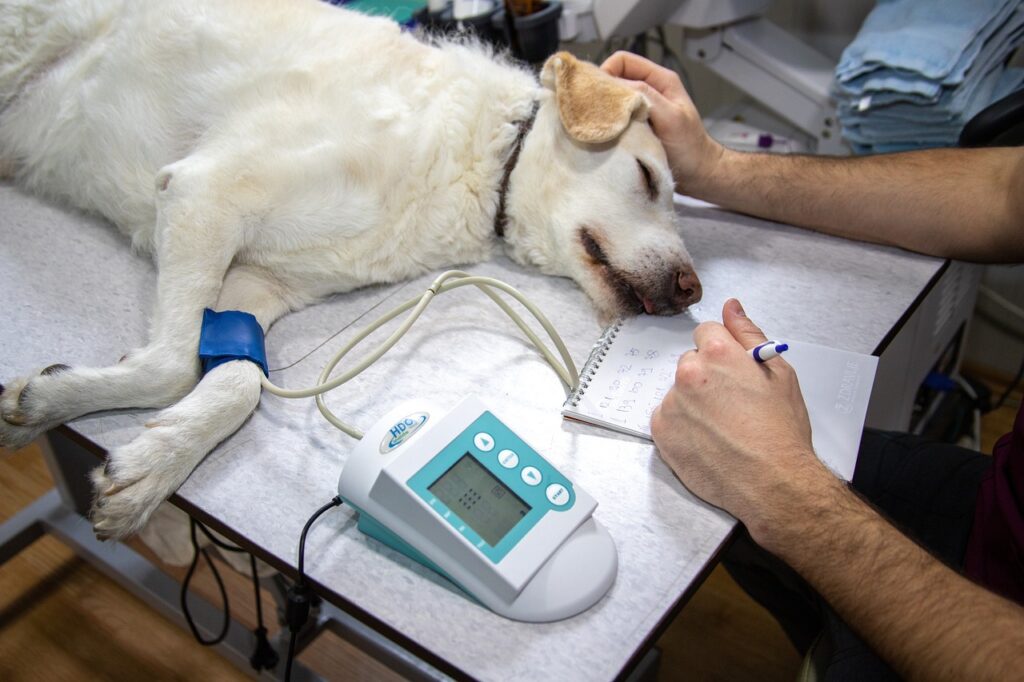| Summary: Dog skin tag removal costs vary, ranging from $50 to $500, depending on size, location, and removal method. Vet consultation fees, anesthesia, and lab tests may add to the expense. Cryotherapy is cheaper, while surgical removal costs more. Always consult your vet to determine the best option for your dog. |
Skin tags are a common occurrence in many dogs, and while they’re generally harmless, they can sometimes be a cosmetic concern or even cause irritation. In this guide, I’ll break down everything you need to know about dog skin tag removal cost.
We’ll explore what skin tags are, why they might need to be removed, the procedures available, and the factors that affect the overall cost of removal. Whether you’re considering removal for health, comfort, or aesthetics, this guide aims to provide you with the comprehensive information you need to make an informed decision. The cost of skin tag removal for dogs varies depending on size, location, and veterinary fees. GPS dog collars can help track recovery movements post-procedure.
Find out what style dog collar is best for hounds to ensure comfort and safety for your furry friend.
Blog Highlights
ToggleWhat Are Skin Tags?

Skin tags are small, benign growths that can appear on a dog’s skin. They are typically soft, flesh-colored, and hang off the body by a narrow stalk. Here are some key points to understand about skin tags:
- Nature: Skin tags are non-cancerous and usually harmless. They often occur as dogs age, but they can also appear in younger dogs.
- Location: Common areas for skin tags include the neck, armpits, groin, and under the tail. They can appear anywhere on the body.
- Appearance: They usually vary in size from a few millimeters to over a centimeter. Their texture can be smooth or slightly wrinkled.
In most cases, skin tags do not cause discomfort or health problems. However, if they are located in areas where they get caught on clothing or collars, or if they become irritated or infected, removal might be considered. Removal costs can range from $50 for minor procedures to over $500 if sedation or surgery is needed. Pet tech products like pet insurance trackers can help manage vet expenses.
Reasons for Skin Tag Removal

While skin tags are typically harmless, there are several reasons why you might consider having them removed from your dog:
- Irritation or Discomfort: Skin tags that are frequently rubbed by a collar or leash can become irritated. Dogs might lick or bite at them, leading to discomfort or even infection.
- Cosmetic Reasons: Some pet owners opt for removal if the skin tags are large or located in visible areas, especially if they affect the overall appearance of the pet.
- Infection Risk: If a skin tag becomes inflamed or infected, removal may be necessary to prevent further complications.
- Preventative Measures: In some cases, a vet may recommend removal if there is any uncertainty about the growth. Although skin tags are usually benign, it can be reassuring to have them examined and removed if needed.
Understanding why removal might be necessary helps you decide if this is the right choice for your pet, especially when considering the cost and the procedure involved. Some vets offer cryotherapy or laser removal, which may be more affordable than surgical excision. Electronic dog collars can prevent excessive licking or irritation post-surgery.
The ideal size collar for English Springer Spaniel typically ranges from 14 to 20 inches, depending on the dog’s age and neck size, ensuring a comfortable and secure fit.
Methods for Removing Skin Tags
There are several methods for removing skin tags from dogs, and the appropriate choice often depends on the size, location, and number of skin tags, as well as the overall health of your pet. Here are some common removal methods:
1. Surgical Excision
Surgical excision involves the removal of the skin tag with a scalpel. This is typically performed under local anesthesia, although sedation may be used for more anxious dogs. If removal isn’t necessary, vets may recommend monitoring rather than surgery. Dog training equipment can assist in keeping dogs calm during vet visits.
- Procedure: The veterinarian cleans the area, numbs it with a local anesthetic, and then carefully cuts off the skin tag. The wound may be closed with sutures if necessary.
- Cost Factors: The cost of surgical excision can vary depending on the complexity of the procedure and whether sutures are required.
2. Cryotherapy (Freezing)
Cryotherapy involves freezing the skin tag with liquid nitrogen. This method is less invasive than surgical excision and is often used for smaller tags.
- Procedure: The vet applies liquid nitrogen to the skin tag, which freezes and eventually causes the tag to fall off over time.
- Cost Factors: Cryotherapy tends to be less expensive than surgical excision, but multiple sessions may be required for complete removal.
3. Electrocautery
Electrocautery uses an electric current to burn off the skin tag. It is a relatively quick procedure that may be performed under local anesthesia.
- Procedure: The vet applies a controlled electric current to the skin tag, causing it to burn and detach from the skin.
- Cost Factors: The cost of electrocautery is comparable to surgical excision, but it may be more cost-effective for certain sizes and locations of skin tags.
4. Laser Removal
Laser removal is a newer method that uses a focused laser beam to remove the skin tag. It is precise and minimizes bleeding.
- Procedure: A laser is used to target the skin tag, effectively vaporizing it while minimizing damage to surrounding tissues.
- Cost Factors: Laser removal is generally the most expensive option due to the specialized equipment and expertise required.
Each of these methods has its advantages and disadvantages. Your veterinarian will consider factors such as the number, size, and location of the skin tags, as well as your dog’s overall health and temperament, to recommend the best removal method.
The recommended size collar for an English Cocker Spaniel usually ranges from 12 to 18 inches, providing a snug and comfortable fit for your dog.
Factors Affecting the Cost of Skin Tag Removal
The cost of skin tag removal for dogs can vary widely based on several key factors. Here are the primary considerations that will impact the final bill:
1. Number of Skin Tags
- Single vs. Multiple: Removing one skin tag may cost less than removing several at once. Some veterinarians offer package deals for multiple removals.
2. Size and Location of Skin Tags
- Size: Larger skin tags might require more time and a more invasive procedure, which can increase the cost.
- Location: Skin tags in hard-to-reach areas or sensitive locations may require more careful handling, potentially increasing the cost.
3. Type of Removal Procedure
- Method Used: As discussed, the method of removal (surgical excision, cryotherapy, electrocautery, or laser removal) will affect the cost. Generally, cryotherapy tends to be less expensive, while laser removal is on the higher end.
- Anesthesia Requirements: If sedation or general anesthesia is needed due to the dog’s temperament or the complexity of the removal, the cost will be higher.
4. Geographic Location and Clinic
- Veterinary Clinic Fees: Costs can vary based on the clinic’s location, with urban areas or specialized clinics typically charging more than rural or general veterinary practices.
- Veterinarian Expertise: Experienced veterinarians or specialists might charge a premium for their services.
5. Follow-Up Care

- Aftercare Instructions: Some procedures might require follow-up visits to check on the healing process. These additional visits can add to the overall cost.
- Complications: If any complications arise during or after the procedure, additional treatments or medications may be necessary, further increasing the cost.
Understanding these factors can help you anticipate the potential cost range and discuss options with your veterinarian before proceeding with skin tag removal.
To find the perfect fit, learn more about what size collar for a Bichon, ensuring your dog’s comfort and safety.
Dog Skin Tag Removal Cost: Estimated Cost Range
While prices can vary, here are some general cost estimates based on the type of removal method:
- Cryotherapy: Approximately $50 to $150 per skin tag. This method may be more cost-effective for small, uncomplicated skin tags.
- Surgical Excision: Typically ranges from $100 to $300 per skin tag, depending on the complexity and whether sutures are needed.
- Electrocautery: Often falls within a similar range as surgical excision, around $100 to $300 per skin tag.
- Laser Removal: Can cost between $200 and $500 per skin tag, making it the most expensive option in many cases.
Keep in mind that these are rough estimates. The actual cost for your dog might be higher or lower based on the factors mentioned earlier. It’s always best to consult with your veterinarian for a personalized quote.
| Removal Method | Estimated Cost in the United States |
| Surgical Excision | $150 – $200 per skin tag |
| Cryotherapy | $150 – $200 per skin tag |
| Electrocautery | $150 – $200 per skin tag |
| Laser Removal | $200 – $500 per skin tag |
| At-Home Treatments | $7 – $40 per treatment |
The Decision-Making Process
Deciding whether to remove a skin tag from your dog involves balancing the cost against the benefits. Here are some questions to ask yourself and your veterinarian:
Is the Skin Tag Causing Discomfort or Health Issues?
If the skin tag is not causing any irritation or health problems, you might decide to leave it alone. Many skin tags are completely harmless and don’t require removal.
Is the Skin Tag Affecting Your Dog’s Quality of Life?
Consider if the skin tag is interfering with your dog’s daily activities. For example, if it’s in an area that gets frequently irritated by a collar or leash, removal might improve your pet’s comfort.
What Are the Risks vs. Benefits of Removal?
Discuss with your veterinarian the potential risks of the procedure compared to the benefits. While removal can alleviate discomfort and reduce infection risk, every procedure carries some level of risk.
Can the Procedure Be Done Economically?
If cost is a significant concern, ask your vet if there are less expensive alternatives or if the procedure can be performed in multiple sessions to spread out the cost.
How Will the Skin Tag Look After Removal?
For pet owners concerned about aesthetics, consider discussing with your vet the expected appearance after removal. Some methods may leave minimal scarring, while others might leave a small mark.
By carefully weighing these considerations, you can make an informed decision that best supports your dog’s health and well-being.
My Personal Experience and Considerations
In my own experience, I encountered a situation where one of my dog’s skin tags was causing minor irritation because it would frequently get caught on his collar. After discussing the issue with my veterinarian, we decided that surgical excision was the best option.
Although the cost was a bit higher than other methods, the procedure was quick, and the recovery was smooth. My dog experienced minimal discomfort, and the removal significantly improved his quality of life.

I learned that while cost is an important factor, the overall health and comfort of your pet should always be the top priority. Investing in a slightly more expensive procedure that ensures safety and effective removal is worthwhile if it means preventing future complications.
Discover the ideal option by exploring what is the best collar material for a Bichon Frise to ensure your pet’s comfort and durability.
Questions to Ask Your Veterinarian
Before proceeding with skin tag removal, consider asking your veterinarian the following questions:

- What method do you recommend for removing my dog’s skin tag, and why?
- Can you provide an estimate of the cost for removal, including any follow-up visits?
- Are there any risks associated with the procedure?
- How should I care for my dog after the removal to ensure proper healing?
- What signs should I look for that might indicate a complication?
These questions will help ensure you have a clear understanding of the procedure, costs, and aftercare requirements.
Final Thoughts and Recommendations
Skin tag removal in dogs is a common procedure that is generally safe when performed by a qualified veterinarian. The Dog Skin Tag Removal Cost can vary widely depending on the method used, the size and location of the skin tag, and other individual factors. While skin tags are typically harmless, removal may be warranted if they cause irritation, discomfort, or pose a risk of infection.
Ultimately, the decision to remove a skin tag should be based on your dog’s overall health, quality of life, and the advice of your veterinarian. It is important to budget for these procedures, as the costs can add up, especially if your dog has multiple skin tags. Remember that investing in your pet’s health now can help prevent more serious and costly issues down the road.
The American Staffordshire Terrier’s coat type is short, sleek, and easy to maintain with regular brushing.
For pet owners facing this decision, my advice is simple: communicate openly with your veterinarian, ask all the questions you need, and carefully weigh the pros and cons. While the cost of skin tag removal might seem daunting at first, it is often a one-time investment that can provide significant benefits in terms of comfort and overall health.





